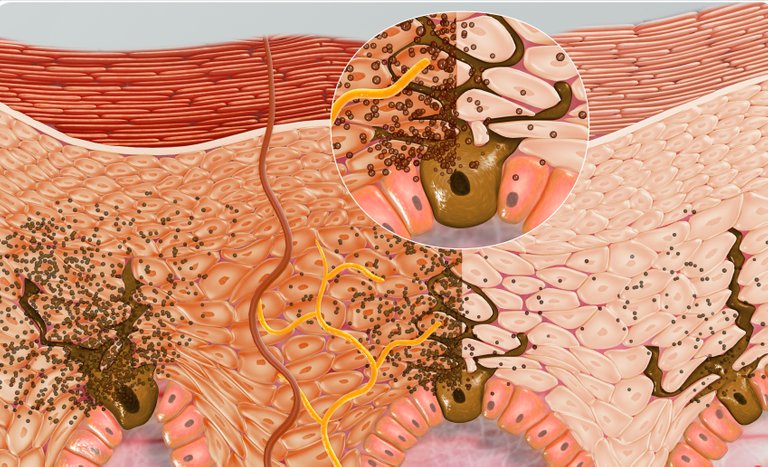Explaining Skin Pigmentation and Melanin Creation
Black, White, Red, and hmmm..... I don't know what other color of skin you know, but one thing that we all have in our skin is the Molecule Melanin. You might say, but I thought I heard my teacher saying that melanin is synonymous with dark skin people, well you heard wrongly because melanin is in everyone's skin and today, we will be discussing the physiology of Melanin. You should sit back, get that pen and jotter and do some jotting if you are a student. Oh, I forgot this is a social media platform built on the blockchain but that doesn't matter, we learn everywhere. So get that pen, and paper, and start jotting down whatever you would need in this post because I will be doing justice to Melanin, the skin's compulsory molecule for all. Quick one, Melanin is that pigment responsible for the color of our skin, hair, and eyes. It is produced by cells known as melanocytes, which are found in the epidermis of the skin which is the outer layer of the skin.
Melanin is the protective molecule in the skin that protects the underlying tissues and DNA from ultraviolet rays which could cause the DNA to mutate. Thymine is a molecule present in our DNA, and when exposed to Ultraviolent light can mutate as its double bond splits in a homolytic bond cleavage forming a cyclobutane thymine dimer which is a mutation as a result of ultraviolet ray exposure which is the most common reason for skin cancer. One way that UV light gets in contact with the skin is from the sun, which can get into the skin and cause mutation but melanin molecules are effective in blocking UV rays from penetrating into the molecules in the body and mutating the DNA of the body. Melanin is a polymer of 5,6-dihydroxyindole (DHI) and 5,6-dihydroxyindole-2-carboxylic acid, and these serve as a light absorption pigment, preventing UV light from causing free radicals in DNAs which are very dangerous. When one is exposed to sunlight, the anterior pituitary gland synthesizes melanocyte-stimulating hormones to bind with melanocyte-stimulating hormone receptors which activate adenylate cyclase and the activation of Protein Kinase A.
Let's quickly do a diversion that would be needed throughout this post. You must have heard about the word Keratin, Keratin is a protein produced by Keratinocytes which are cells found in all parts of the skin. They exist in all layers of the skin protecting the epidermis and responsible for the thickness of the skin. Keratinocyte is not responsible for making melanin, melanin is produced by the melanocyte. Melanocytes produce melanin and send them to the keratinocytes. It is important to know that melanocytes only exist in the stratum basale so the transfer of melanin to the keratinocyte is done in the stratum basale. The external part of the skin does not have a nucleus and does not have to worry about mutation, but in the stratum basale, the cells possess a nucleus that is mitotically active. When there is Ultraviolet light penetrates the keratinocyte, the DNA is damaged, and a protein called P53 increases the expression of the protein proopiomelanocortin (POMC). POMC is lysed releasing an alpha-Melanocyte-stimulating hormone that binds to the melanocyte-stimulating hormone receptors causing an increase in the proteins needed to stimulate melanin and increasing the production of melanin inside the melanosomes of the melanocyte. When this happens, The melanocyte transfers melanosome into the keratinocyte after which they degranulate releasing melanin which shields the nucleus of the keratinocytes from Ultraviolent rays as they can absorb the rays from the UV light, dissipating the light wave as heat in the body. This is why when a person is in the sun for a very long time, their pigmentations increases.

https://commons.wikimedia.org
Why do people in a certain region have darker skin color than others? This will lead me to explain the Biosynthesis of melanin. People with Eumelanin tend to have darker skin compared to people with Pheomelanin. The pigmentation of the skin doesn't have to do with the number of melanocytes in the skin, it has to do with the activity of the melanocyte in the skin.
Eumelanin is a type of Melanin that is more in darker people than pheomelanin, and Pheomelanin is more in people with light skin than Eumelanin. Eumelanin and Pheomelanin start with the amino acid tyrosine, which is converted by Tyrosinase to dopaquinone or L-Dopa in the cytoplasm of the melanocyte (lack of Tyrosinase in converting thyroxine leads to albinism). Dopaquinone is the precursor of both Pheomelanin and Eumelanin. In Eumelanin, dopaquinone is converted to Leukodopachrome through a cyclization reaction, the dopaquinone can also be converted to dopachrome which can still experience a reverse reaction back to L-dopa, or be decarboxylated to form dihydroxyindole which can react with Tyrosinase to form indolequinone. Dopachrome reacts with Tyrosinase-related Protein 2 (TRP-2) to form 5,6-dihydroxyindole-2-carboxylic Acid (DHICA). Also, Leukodopachrome can also be converted to 5,6-Indolequinone-2-carboxylic acid. The 5,6-dihydroxyindole-2-carboxylic Acid, 5,6-Indolequinone-2-carboxylic acid, and indolequinone get polymerized with the help of a catalyst protein Tyrosinase Related Protein 1 (TRP-1) to form Eumelanin.
In the Pheomelanin pathway, the Dopaquinone which is a precursor is transferred to the pheomelanosome which then combines with Cysteine to form 5-S-cysteine Dopa (5SCD) and 2-S-cysteine dopa (2SCD) which will then be oxidized by tyrosinase to form cysteine dopa-quinones, which will then undergo cyclization to give Benzothiazine intermediates which then be polymerized vis oxidation to become Pheomelanin. This is the reddish pigment compared to Eumelanin which is brownish or darkish. People who are brownish are activities towards the Eumelanin than Pheomelanin. Both types of skin color possess both types of melanin but at different concentrations.
https://www.ncbi.nlm.nih.gov/pmc/articles/PMC2671032/
https://www.nature.com/articles/s41467-020-18393-w
https://www.sciencedirect.com/topics/neuroscience/pheomelanin
https://www.ncbi.nlm.nih.gov/pmc/articles/PMC6444329/
https://www.ncbi.nlm.nih.gov/pmc/articles/PMC1178012/
https://www.ncbi.nlm.nih.gov/books/NBK459156/
https://www.statpearls.com/ArticleLibrary/viewarticle/24925
https://www.ncbi.nlm.nih.gov/pmc/articles/PMC2562678/
https://www.ncbi.nlm.nih.gov/pmc/articles/PMC4299862/
https://www.ncbi.nlm.nih.gov/pmc/articles/PMC8348573/
https://www.ncbi.nlm.nih.gov/pmc/articles/PMC2736122/
https://www.ncbi.nlm.nih.gov/pmc/articles/PMC4130143/
https://www.ncbi.nlm.nih.gov/books/NBK22268/
https://www.ncbi.nlm.nih.gov/pmc/articles/PMC218148/

Hi, I am Tobi a writer, speaker, relationship blogger, and lover of good music. I love making friends and learning from people. Want to hear me speak on relationships and general life issues, you can find my podcast channel Here and I also have a youtube channel where you can listen and watch any episode for free, do not forget to subscribe and share with friends. I sincerely appreciate every love I get from members of the community and do well to keep them coming.

Melanin is in everyone, that's the way it is, even in albinos, they have very little, but they still have it.
The molecular process for the formation of any component is quite complicated, complex, but interesting.
You have explained it in a quite simple way to tell the truth, thank you.
Thanks for your contribution to the STEMsocial community. Feel free to join us on discord to get to know the rest of us!
Please consider delegating to the @stemsocial account (85% of the curation rewards are returned).
Thanks for including @stemsocial as a beneficiary, which gives you stronger support.